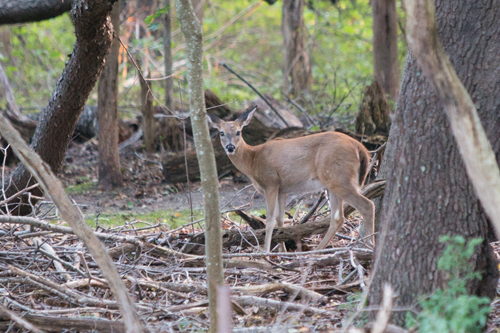Guest Spot: Cars and deer make for a costly mix

We’ve all seen it: A deer carcass lying at the edge of the road, the gruesome result of a car/deer collision. It’s not a pretty sight. And while it tells a story, it doesn’t tell the whole story.
There are some sobering facts about car/deer collisions in Southold. The most alarming is that your chance of hitting a deer here is 2.5 times the national average — or one deer collision for every 63 local registered drivers. That’s all drivers, including you, your spouse or partner, parents, children or grandchildren. If you own or run a motel or B&B, if you rent out your home or if you just enjoy sharing your home with out-of-town friends, they all face this increased risk. For first-time drivers, older drivers and out-of-towners, it’s even more frightening because these drivers are less experienced on local roads and less able to safely avoid such collisions.
I knew a woman who was firmly in the “don’t touch the deer” camp; that was until one of her children ran his car off the road and into a tree because he was trying to avoid deer racing across the road just a few hundred yards from their home. Her position has, understandably, changed.
Her story also points to another issue. Besides the numerous car/deer collisions, many accidents are the result of people avoiding deer. Such accidents are not always reported as deer-related, so the number of car accidents caused by deer is actually higher. Southold Police Chief Martin Flatley estimates at least 30 percent of accidents involving deer go unreported “because either the vehicle damage is minor or motorists would prefer their insurance carriers are not involved.”
And all of this translates to added costs for the rest of us. State Farm, one of the nation’s leading insurers, put last year’s average national cost per claim for deer collisions at $3,888, up 13.9 percent from $3,414 in 2013. And over the last four years, the number of deer-related claims paid has increased 7.9 percent while other similar auto claims have declined by 8.5 percent.
Figures from the Southold Town Police Department document 229 reported car/deer collisions in the town during 2014. That’s up from 144 such accidents reported in 2000, the year Southold started tracking this information. This translates to a 61 percent increase. One in every 4.8 Southold drivers has had a deer accident in the last 15 years. And in the peak season, October through December, there’s an average one car/deer collision per day in Southold.
It has been asserted that fencing has contributed to channeling deer onto our roads but, to dispel this rumor, there are as many deer accidents reported in areas without fencing.
If you carry liability-only auto insurance and you hit a deer, you’re responsible for the full repair bill. If you believe this type of accident would trigger a collision insurance claim, you’d be wrong. Insurance companies do not include this type of accident in the definition of a collision. Your policy must contain comprehensive coverage, sometimes referred to as other-than-collision coverage (OTC), in order to have such damage repair paid for by insurance.
So there’s a cost to you in many ways, some obvious but some not so clear. First, you need to purchase full insurance coverage to minimize your out-of-pocket costs. Second, deer accidents, or near misses, tend to cause multiple vehicle collisions as well, which also affects your premiums. Third, the amount of your premium is based on your Zip code and as an area with a high deer population, our rates are higher than elsewhere in New York State.
But there are “hidden” costs we all pay for. Just as residents pay higher insurance rates, so does the Town for its fleet of vehicles.
Chief Flatley said, “Due to the continuous hours that police vehicles are driven on the roads of Southold Town during the course of their patrolling, they are even more susceptible to striking a deer while driving. We must plan for at least five to eight visits to an auto body repair shop per year to repair vehicles in our fleet.”
Add to that the costs for the police to respond to deer collisions and for the highway department to send a crew to pick up and properly dispose of a deer carcass and you can see how costs keep growing.
Connecticut recently completed a study revealing that towns in Fairfield County each spend between $1.9 million (Sherman) and $17 million (Fairfield) annually because of the consequences of deer overpopulation. These totals include highway department costs, car repairs, private and municipal auto insurance and even increased health insurance premiums due to high levels of tick-borne illnesses like Lyme disease, as well as injuries from car accidents. On a per household basis this works out to spending of between $380 (Bridgeport) and $1,520 (Redding), some of which is paid directly by the resident and some of which is captured through higher taxes for all property owners.
In other words, we are all paying the costs associated with deer overpopulation here on the East End. Some of these costs involved in higher charges for auto insurance and repairs. Some reflect serious injuries, or even a reported death, of loved ones involved in accidents. When is the cost too much?
In 2014, Southold had 229 deer/auto collisions, 2.5 times the national average. This is too many! Our failure to bring down the number of accidents indicates that our deer management efforts have not been sufficient to get ahead of this problem. When will we agree that something more must be done?
Since much of the land in Southold Town is privately owned, deer management by individual landowners is extremely important in reducing the local deer population. If you have a parcel that routinely hosts a number of deer and are interested in having a hunter hunt your property, call Southold Town at 631-765-1283 for assistance with contact information.
 John Severini of Greenport is the founder and CEO of GP Consulting, specializing in data management. He’s also an environmental activist and a member of Southold Town’s committee on deer management. This is the fifth in a series of six Guest Spots being submitted by the North Fork Deer Management Alliance. They are being published over the course of six months.
John Severini of Greenport is the founder and CEO of GP Consulting, specializing in data management. He’s also an environmental activist and a member of Southold Town’s committee on deer management. This is the fifth in a series of six Guest Spots being submitted by the North Fork Deer Management Alliance. They are being published over the course of six months.








